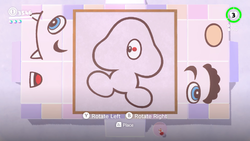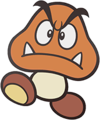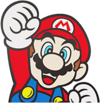Picture Match: Difference between revisions
(Putting both Goomba and Mario in one paragraph, so that the second is about the harder version of both games. Also mechanics of each part. Power Moon names) |
m (second to last paragraph worded better) |
||
| Line 17: | Line 17: | ||
}} | }} | ||
There is a more difficult version of both Picture Match minigames. These versions are only available after completing the initial version of each minigame. In addition, to play the Cloud Kingdom version, the player must activate the kingdom's [[Moon Rock]]. In this version, all colors and outlines of the picture except for outermost outline fade out soon after the game starts, leaving the picture as a blank white silhouette. The colors and outlines return during the transition to judging. The passing score is increased to a minimum of 80 points. If this is completed, Mario receives another Power Moon. In the Cloud Kingdom, this is [[List of Power Moons in the Cloud Kingdom#Picture Match: A Stellar Goomba!|Picture Match: A Stellar Goomba!]]. In the Mushroom Kingdom, this is [[List of Power Moons in the Mushroom Kingdom#Picture Match: A Stellar Mario!|Picture Match: A Stellar Mario!]]. There is no way to play the first version of the game again without creating a new save file. | |||
The background music that plays in the Picture Match areas is a rendition of "[[Spinning Slots]]" from ''[[Super Mario Bros. 3]]''. | The background music that plays in the Picture Match areas is a rendition of "[[Spinning Slots]]" from ''[[Super Mario Bros. 3]]''. | ||
Revision as of 00:09, September 14, 2024
Picture Match is a minigame featured in Super Mario Odyssey. It appears in the Cloud Kingdom and the Mushroom Kingdom and involves replicating an image of a character as accurately as possible using capturable objects called Picture Match Parts. A Toad wearing a beret hosts both games, and the game is both started and concluded by talking to them. In the Cloud Kingdom, the game is accessed through a Warp Pipe in the center of Nimbus Arena, and the image is of a Goomba. The parts involved are its eyes, eyebrows, and mouth. The Warp Pipe only appears after first completing Hat-to-Hat Combat and returning to the Cloud Kingdom. In the Mushroom Kingdom, the game is accessed by taking a Mini Rocket from near the Goomba Woods into the sky, and the image is of Mario. The parts involved are his eyes, eyebrows, nose, mustache, and mouth.
When the game starts, the game switches to an overhead view of the image, which is placed on the surface of a platform with ramps leading up from the ground. Once the player confirms, the facial features of the image will vanish, replaced by a set of Picture Match Parts on the platform. As a Picture Match Part, Mario can move around and rotate the part with and
. Each button goes in a different direction. Picture Match Parts cannot jump. They are placed by exiting the part. If the part is not mostly on the image, it resets back to the original position. If it is, the part can no longer be captured, and disappears a few seconds after. Both Goomba and Mario parts appear in both games, so it is also important to choose the correct parts. Picture Match Parts are unable to leave the platform.
When the player is done placing parts, they can talk to the Toad again to start scoring. The camera returns to the overhead position, and all of the placed Picture Match Parts reappear one after the other. Points are earned by placing the Picture Match Parts in similar positions and orientations to the original image. A score of at least 60 points passes and the Toad gives Mario a Power Moon. In the Cloud Kingdom, this is Picture Match: Basically a Goomba. In the Mushroom Kingdom, this is Picture Match: Basically Mario.
There is a more difficult version of both Picture Match minigames. These versions are only available after completing the initial version of each minigame. In addition, to play the Cloud Kingdom version, the player must activate the kingdom's Moon Rock. In this version, all colors and outlines of the picture except for outermost outline fade out soon after the game starts, leaving the picture as a blank white silhouette. The colors and outlines return during the transition to judging. The passing score is increased to a minimum of 80 points. If this is completed, Mario receives another Power Moon. In the Cloud Kingdom, this is Picture Match: A Stellar Goomba!. In the Mushroom Kingdom, this is Picture Match: A Stellar Mario!. There is no way to play the first version of the game again without creating a new save file.
The background music that plays in the Picture Match areas is a rendition of "Spinning Slots" from Super Mario Bros. 3.
See also
Names in other languages
Picture Match
| Language | Name | Meaning | Notes |
|---|---|---|---|
| Chinese (simplified) | 拼图[?] Pīntú |
Jigsaw Puzzle | |
| Chinese (traditional) | 五官拼圖[?] Wǔguān pīntú |
Facial features jigsaw Puzzle | |
| Dutch | Dubbelgangers[?] | Doppelgängers | |
| French | Portrait craché[?] | Spitting image | |
| German | Gesichterpuzzle[?] | Face puzzle | |
| Italian | Salva la faccia[?] | Save the face | |
| Korean | 그림 맞추기[?] Geurim Matchugi |
Picture Matching | |
| Russian | Фоторобот[?] Fotorobot |
Photo robot | |
| Spanish | Retratista[?] | Portrait painter |
Picture Match Part (Goomba)
| Language | Name | Meaning | Notes |
|---|---|---|---|
| Chinese (simplified) | 蒙眼贴画(栗子小子)[?] Méng yǎn tiēhuà (Lìzǐ Xiǎozi) |
Blindfolded Sticker (Goomba) | |
| Chinese (traditional) | 鬼臉(栗寶寶)[?] Guǐliǎn (Lìbǎobǎo) |
Grimace (Goomba) | |
| Dutch | Gezichtselement (Goomba)[?] | Facial Feature (Goomba) | |
| French | Portrait craché (Goomba)[?] | Picture Match (Goomba) | |
| German | Gesichterpuzzleteil (Gumba)[?] | Face Puzzle Part (Goomba) | |
| Italian | Pezzo di Salva la faccia (Goomba)[?] | Picture Match Part (Goomba) | |
| Korean | 얼굴 맞추기(굼바)[?] Eolgul Matchugi(Gumba) |
Face Match (Goomba) | |
| Russian | Элемент фоторобота «Гумба»[?] Element fotorobota «Gumba» |
Picture Match Part (Goomba) | |
| Spanish (NOA) | Pieza del Retratista (goomba)[?] | Picture Match Part (Goomba) | |
| Spanish (NOE) | Pieza del Retratista (Goomba)[?] | Picture Match Part (Goomba) |
Picture Match Part (Mario)
| Language | Name | Meaning | Notes |
|---|---|---|---|
| Chinese (simplified) | 蒙眼贴画(马力欧)[?] Méng yǎn tiēhuà (Mǎlìōu) |
Blindfolded Sticker (Mario) | |
| Chinese (traditional) | 鬼臉(瑪利歐)[?] Guǐliǎn (Mǎlìōu) |
Grimace (Mario) | |
| Dutch | Gezichtselement (Mario)[?] | Facial Feature (Mario) | |
| French | Portrait craché (Mario)[?] | Picture Match (Mario) | |
| German | Gesichtpuzzleteil (Mario)[?] | Face Puzzle Part (Mario) | |
| Italian | Pezzo di Salva la faccia (Mario)[?] | Picture Match Part (Mario) | |
| Korean | 얼굴 맞추기(마리오)[?] Eolgul Matchugi(Mario) |
Face Match (Mario) | |
| Russian | Элемент фоторобота «Марио»[?] Element fotorobota «Mario» |
Picture Match Part (Mario) | |
| Spanish | Pieza del Retratista (Mario)[?] | Picture Match Part (Mario) |
References
- ^ Sakai, Kazuya (Ambit), kikai, Akinori Sao, Junko Fukuda, Kunio Takayama, and Ko Nakahara (Shogakukan), editors (2015). "Super Mario Sunshine" -『スーパーマリオブラザーズ百科: 任天堂公式ガイドブック』. Tokyo: Shogakukan (Japanese). Page 105.
- ^ ---- (2015). "Super Mario Galaxy 2."『スーパーマリオブラザーズ百科: 任天堂公式ガイドブック』. Tokyo: Shogakukan (Japanese). Page 169.


